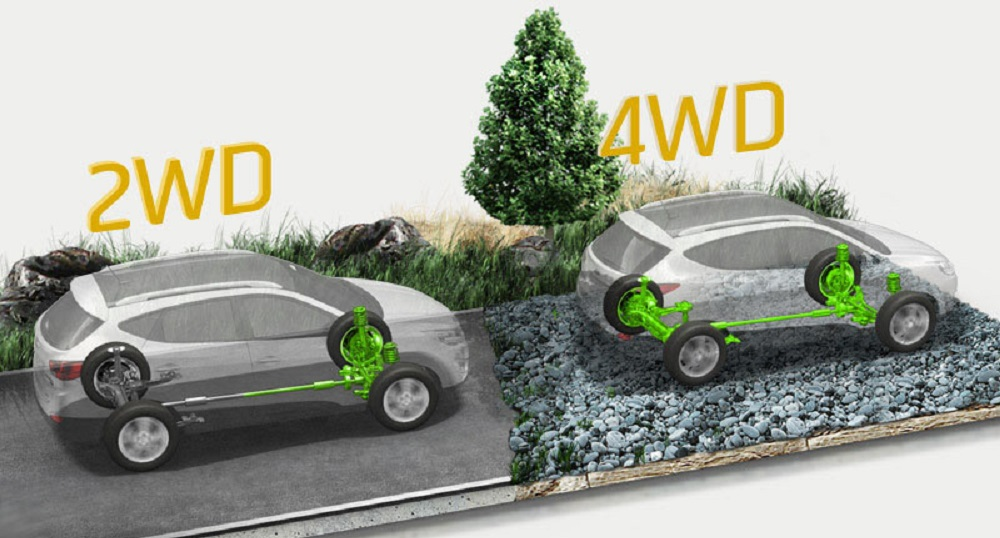
If you’re on the lookout for a new car or want a pre-owned truck, you will need to compare multiple types of drivetrains. A drivetrain is a mechanism responsible for gear shifting on the driving axle, and each drivetrain works in its own way. Some of the drivetrains that you might have come through are FWD, AWD, and 4WD.
Many of you might be aware of these abbreviations, but some may be confused about these drivetrains. Worry no more! Our detailed guide will explain the types of drivetrains and how to choose between FWD, AWD, and 4WD based on your lifestyle. We’ll be discussing the working phenomenon, 4WD vs FWD comparison, and the pros and cons of all the mentioned drivetrain types. Without further ado, let’s get started!
A drivetrain type, also known as a powertrain, is a transmission mechanism that controls the power of the vehicle. The drivetrain delivers the power from its primary mover towards the wheels, depending on the type. A drivetrain includes the following components: axle, wheels, exhaust, and drive shaft. There are different types of drivetrains that you can opt for depending on your needs. Let’s explore the working of each drivetrain:
The front wheel drive transmission mechanism delivers power from the engine towards the front wheels of the vehicle. In this type, no power is being transferred towards the rear wheels of the car or truck. Since the front wheels consume all the power, these two wheels are responsible for moving the car. The majority of vehicles available in the market today have the Front Wheel Drive (FWD), making it the most common drivetrain type.
It can be anticipated from the name what All Wheel Drive (AWD) will do! All Wheel Drive (AWD) has both the front side and rear side wheels powered with the engine, and both axles run simultaneously.
However, it must be noted that All Wheel Drive distributes the power to the front and rear wheels depending on the needs. The sensors and electronic devices in a vehicle judge the traction and deliver more power where needed.
Four Wheel Drive (4WD) vehicles are mostly confused with All-Wheel Drive (AWD) vehicles, but they do have major distinguishing features. The similarity between these two drivetrain types is clear: both utilize and engage all four wheels of the vehicle. However, the difference is that the 4WD vehicles run in Rear Wheel Drive (RWD) mode until all four wheels need to be engaged. For example, you can switch ON/OFF the 4WD feature while driving.
Different types of drivetrain vehicles can be utilized for varied purposes— each one having its own pros and cons. This guide will explore the user cases of FWD, AWD, and 4WD based on your lifestyle:
The most common choice for every user is the Front Wheel Drive (FWD) vehicle. These are the types of vehicles where the power from the engine is transferred to the front axle only. Here are some of the use cases of FWD vehicles:
If you’re looking to buy a car with improved fuel efficiency, then a sedan with FWD is considered the best option. Affordability and efficiency are both included in this option. Additionally, the engine does not need to generate extra power all the time to tow heavy weight, making it lighter when driving.
Since the FWD option is the most available, it’s the cheaper option as well. Not only the one-time cost but also the maintenance and fuel consumption costs are much less for this type of drivetrain.
All-wheel drive is a bit on the higher end than front-wheel drive vehicles due to its greater power and improved road stability. Here’s why you need an AWD in your life:
All Wheel Drive (AWD) vehicles have better traction and road stability. The reason behind this principle is that the AWD transfers power from the engine towards all wheels, making it better at gripping the road. No matter if it’s rainy or slippery conditions on the road, AWD will compensate for the lost grip with the distributed power towards both axles.
If you’re living in a region that experiences more rainfall or snow around the year, the AWD is the right drivetrain for you!
The Four-Wheel Drive (4WD) is better amongst all, only if you love off-roading! This type of drivetrain vehicle comes with improved safety, traction, and stability on challenging off-road paths.
As mentioned above, if you often visit mountain areas or love off-roading, the 4WD is the only option you can opt for! 4WD engages all the wheels at once to improve the road grip and performance.
Apart from the enhanced road grip and safety if you’re looking for a vehicle to transport heavy equipment, 4WD is a must-have vehicle for you! For example, if you love camping, you might have to carry the stove, tents, luggage, and multiple heavy items. On the other hand, if you’re a photographer, cameras, lenses, and stands might need to go along. In all such scenarios, the Four-Wheel Drive will fulfill the purpose.
Choosing from the FWD, AWD, or 4WD depends on the individual’s sole discretion and varies according to lifestyle. While the FWD offers affordability, AWD and 4WD have better traction and come with increased road safety. However, AWD might keep you going in lighter snowfall and rain, while the 4WD is for challenging off-road conditions. If you have any more queries about drivetrain types, feel free to ask!